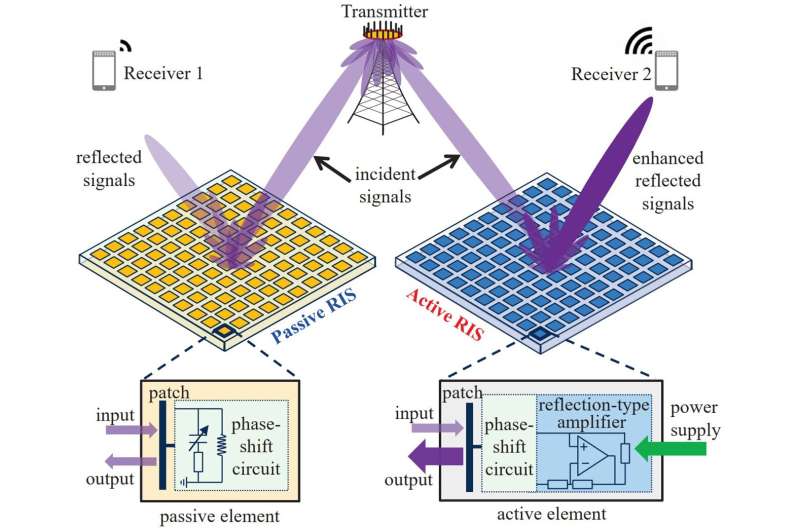
Recently, a new technology named reconfigurable intelligent surface (RIS) has emerged as a potential candidate for the 6G network. An RIS is usually designed as a reflective array equipped with a large number of passive elements, each being able to reflect the incident signals passively with a controllable phase shift.
By properly adjusting the phase shifts of massive RIS elements, the reflection-type beamforming with high array gains can be achieved by RISs to enhance the wireless communications significantly.
“Although the number of publications about RISs has recently sharply increased, most existing works mainly focus on the algorithmic designs of RISs under the ideal assumptions,” said Prof. Linglong Dai, a Professor in the Department of Electronic Engineering of Tsinghua University, Beijing, China. “Limited by the physical characteristics the limitation in practical scenarios, many challenging issues of RISs are still worth further investigating.”
In a recently published article of Prof. Dai’s research team, which is published in Tsinghua Science and Technology, the RIS technology is systematically overviewed by explaining its basics, clarifying nine fundamental issues, and revealing one critical problem. Specifically, the research team first explained the basics of RIS including its working principles, design methods, and potential benefits for wireless communication, aiming to sort out a clear technical route for the RIS developments.
Based on these basics, nine fundamental issues of RISs are explicitly explained to elaborate their technical features, distinguish them from existing technologies like relay, and clarify some misunderstandings in the literature. In particularly, these nine fundamental issues include:
- What’s The Difference Between RIS and Massive MIMO?
- What’s The Difference Between RIS and Relay?
- Is RIS Just Reflective?
- Is RIS Really Passive?
- Does RIS Not Introduce Noise?
- Can RIS Achieve The “Square-Law” Asymptotic Array Gain?
- Is RIS Really Intelligent?
- How Can RIS Achieve Passive Beamforming Efficiently?
- Is RIS Really Power Saving?
After answering these questions above, the researchers revealed one critical problem that, due to the “multiplicative fading” effect, common RISs with hundreds of elements can hardly achieve visible gains in general communication scenarios with strong direct links.
The team member Zijian Zhang explained that, “the multiplicative fading effect means that, the equivalent path loss of the transmitter-RIS-receiver reflected link is the product of the path losses of the transmitter-RIS and RIS-receiver links, and thus it is thousands of times larger than that of the unobstructed direct link. Thereby, for an RIS to realize a noticeable capacity gain, thousands of RIS elements are required to compensate for this extremely large path loss.”
To address this critical problem, Prof. Dai’s team introduced a potential solution called active RISs, which was proposed in their recent technical work. “Different from the existing passive RISs, which passively reflect signals without amplification,” said Prof. Dai. “The key feature of active RISs is to amplify the reflected signals by integrating active components at the RIS elements.”
“Apart from the phase-shift circuit for the passive RIS element, each active RIS element is additionally equipped with an active reflection-type amplifier, which can amplify the reflected signals at the cost of affordable power consumption and hardware cost,” said Zhang. “A recent research has shown that, by amplifying the reflected signals, the multiplicative fading of RIS aided links can be converted to an additive fading so as to overcome the large path loss.”
To reveal the substantial capacity gain of active RISs in real-world system, Prof. Dai’s team has also developed a 64-element active RIS aided wireless communication prototype working at 3.5 GHz with the bandwidth of 40 MHz. Based on this prototype, the significant gain of active RISs was validated by experimental measurements.
“We expect that this article will inspire and stimulate more creative ideas and solutions to advance the application of RISs for future 6G wireless communications,” said Prof. Dai.
More information:
Zijian Zhang et al, Reconfigurable Intelligent Surfaces for 6G: Nine Fundamental Issues and One Critical Problem, Tsinghua Science and Technology (2023). DOI: 10.26599/TST.2023.9010001
Provided by
Tsinghua University Press
Citation:
Reconfigurable intelligent surfaces for 6G: Nine fundamental issues and one critical problem (2023, May 23)
retrieved 23 May 2023
from https://techxplore.com/news/2023-05-reconfigurable-intelligent-surfaces-6g-fundamental.html
This document is subject to copyright. Apart from any fair dealing for the purpose of private study or research, no
part may be reproduced without the written permission. The content is provided for information purposes only.
For all the latest Technology News Click Here
For the latest news and updates, follow us on Google News.

